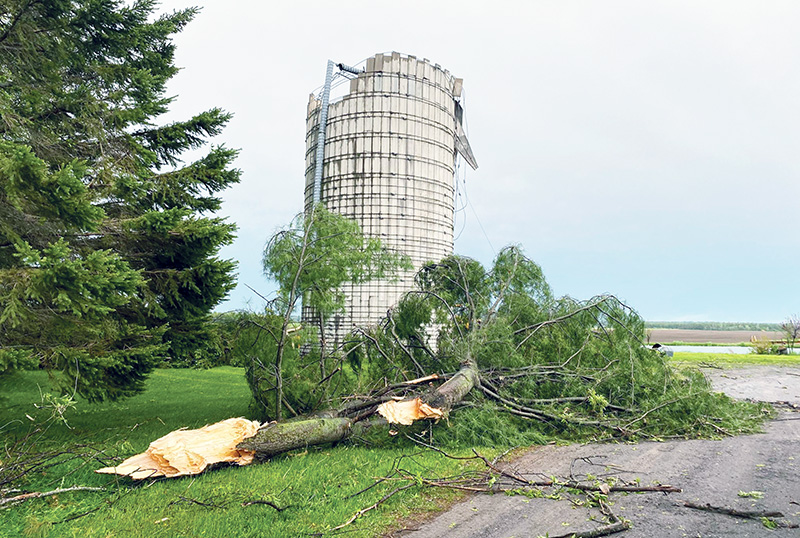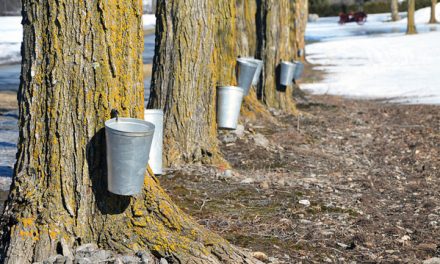A silo at the Wahler farm was damaged by the storm. Courtesy Photo
ST. PASCAL – The horrific summer storm that swept through Southern Ontario on May 21 surprised residents.
The storm spared SD&G for the most part but did knock down trees here and there and destroyed barns and farms as it blasted through the area.
Eleven people were killed along the storm’s path including a woman from Cornwall who was camping in Peterborough County in North Kawartha Township. Police identified Joanne Labelle; 64 years old who was struck by a tree. The other fatalities were throughout Southern Ontario.
This storm was different from a typical summer storm according to Environment Canada. It is extremely violent with high winds, travels quickly through a region and leaves behind a mess especially in urban areas with downed power lines and trees uprooted in its path.
Environment Canada had alerted residents by cell phone, television and radio that the storm would be life threatening.
Stacy and Klaus Wahler of Wahler Farms Inc. is a cash crop farm growing corn and soyabeans, and is family owned. Stacy said she was born in Nova Scotia where hurricane weather is more common than here. She said she could not remember a storm as fierce as this one. A large garage on her home farm was damaged, a couple of trees came down and they lost a gazebo.
Several farms close by lost roofs.
Stacy said she thought this was going to be a typical summer thunderstorm.
She said she had to go to pick up her children who were playing with their friends and all she could see was a wall of rain.
“We got home and went into the basement. It was about 20 minutes before she felt it was safe enough to go back upstairs. Some of us were in the house but the rest of us were in the field.”
“My husband Klaus was in a pickup truck out in the field, and he said he could literally feel the pickup truck being lifted off the ground. All he could do is hope for the best.”
She remembers it was such a beautiful day, everyone was able to go out to the fields to get some work done.
“It will take most of the summer to clean up.”
Stacy said they have grain elevators that were missed by the storm but there was a great deal of debris in the fields that will have to be taken out.
Her farm does not have animals, but they do have a pig outside, and a tree fell on her house, but she is fine. They will have to build a new home for her.
She said other farms have a lot of the silos down.
She was surprised by the devastation left behind by the storm.
Now that the storm has passed and power has been restored after four days, she said the cleanup has to begin.
“Now we are in cleanup mode,” she said.
Most of the Wahler farm damage is around the main farm house and surrounding area. There is a crushed garage, broken trees, damaged silos, some farming equipment that will have to be inspected.
In her farm’s case there is 4,000 acres to be checked out for debris.
“We have all of our corn in but we still have a lot of trees down in the planted fields and that becomes a bigger challenge because you cannot just drive all over the planted fields.”
Debris in an unplanted field means getting everything cleaned up before you begin to plant.
“Now we need to clean up the debris from our soybean fields because we need to get those crops in,” she said.
She said, It will take us to mid-summer for sure to clean everything up.”
“We have to clean up the debris from falling buildings and a couple of those were stone. The silo was stone. We have a machine shed that came down on top of a grain head so that will have to be a priority before harvest time.”
This kind of storm is called a Derecho. It is a Spanish word meaning straight which is how it typically moves. Derechos can cause hurricanic or tornadic-force winds, actual tornadoes, heavy rains, and flash floods. “
A spokesperson for the Weather Network said, “In this case, the damage extended almost 1,000 km from the Michigan border all the way to Quebec City, Que., hitting the most populated part of the country with damaging wind gusts in excess of 120 km/h.”
The Ottawa International Airport measured a record breaking 120 km/h. The previous record was 119 km/h in May of 2018. The Kitchener/Waterloo Airport recorded 132 km/h winds.
Power outages were everywhere along the path of the storm with exception of some communities south of Ottawa and along the St. Lawrence River.













